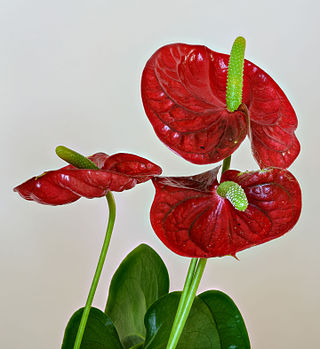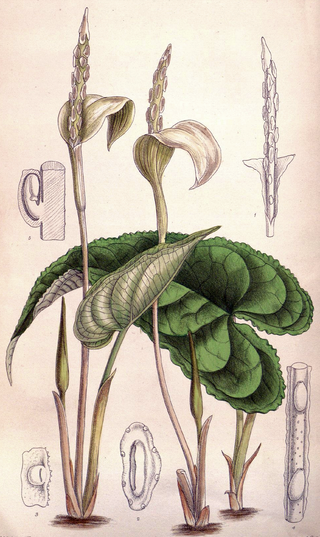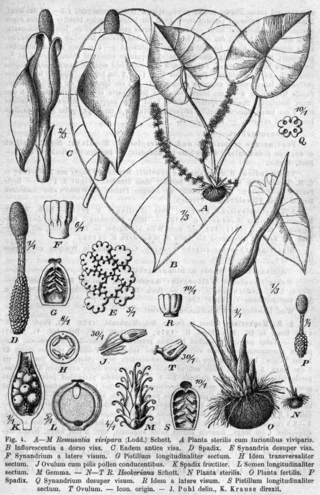
Anthurium is a genus of about 1,000 species of flowering plants, the largest genus of the arum family, Araceae. General common names include anthurium, tailflower, flamingo flower, and laceleaf.
Carlephyton is a genus of four species in the family Araceae, all endemic to Madagascar.

Callopsis is a monotypic genus from the plant family Araceae and has only one species, Callopsis volkensii. This plant forms a creeping rhizome and has cordate-ovate leaves that are medium green and glaborous. The inflorescence is typical of the family Araceae, with a white spathe and yellow spadix. The spadix is shorter than the spathe and its male and female flowers are separated shortly.
Pedicellarum is a monotypic genus of flowering plants in the family Araceae. The single species that comprises the genus is Pedicellarum paiei. This species is endemic to the Island of Borneo.

Holochlamys is a monotypic genus of flowering plants in the family Araceae. Holochlamys beccarii is the only species in the genus Holochlamys. It is native to New Guinea and the Bismarck Archipelago and is found growing in mud near lowland streams or rocky streambeds at high elevations.
Alloschemone is a genus of evergreen root climbing plants in the family Araceae that is native to the Amazon region of Bolivia and Brazil. There are only two species in the genus and both are extremely rare. These two species are Alloschemone occidentalis and Alloschemone inopinata. At one point in history, the genus Alloschemone was dissolved and added to Scindapsus, but it has since been reinstated after further observations of the plants.
Anaphyllopsis is a genus of flowering plants in the family Araceae, native to northern South America.

Anaphyllum is a genus of flowering plants in the family Araceae. It consists of two species. They are found in marshes, have leaves with some pinnation, and have a twisted spathe. The two species in this genus are similar in appearance to those in the genus Anaphyllopsis.
- Anaphyllum beddomeiEngl. - Tamil Nadu, Lakshadweep
- Anaphyllum wightiiSchott. - Kerala, Lakshadweep

Cyrtosperma is a genus of flowering plants in the family Araceae. The genus went through considerable taxonomic changes in the 1980s, and as a result is now considered to be native only to Southeast Asia and some Pacific islands. Previously, the genus was believed to be widespread from Asia to Africa and South America, but the African and South American species were subsequently moved into separate genera. Cyrtosperma is now known to be most prominent in New Guinea. The genus Cyrtosperma is unique in this regards because it is the only known big genus in Araceae that is known to be found east of Wallace's line.
Podolasia is a monotypic genus of flowering plants in the family Araceae. The single known species in the genus is Podolasia stipitata. It is native to Borneo, Sumatra, and Peninsular Malaysia.
Zomicarpella is a genus of flowering plants in the family Araceae. It is native to Colombia, Peru and Brazil. The leaves are hastate or sagittate. The chromosome number for Zomicarpella species is 2n=26. Additionally, the seeds have an endosperm.
- Zomicarpella amazonicaBogner - Amazonas State of northwestern Brazil
- Zomicarpella maculataN.E.Br. - Colombia, Peru
Mangonia is a genus of flowering plants in the family Araceae. The genus contains only two known species native to southern Brazil and Uruguay.
- Mangonia tweedieanaSchott. - Rio Grande do Sul, Uruguay
- Mangonia uruguaya(Hicken) Bogner - Cerro Largo in Uruguay
Filarum is a monotypic genus of flowering plants in the family Araceae. The single species making up the genus is Filarum manserichense. It is found growing in the amazonian region of northeastern Peru. Govaerts, R. & Frodin, D.G. (2002). World Checklist and Bibliography of Araceae : 1–560. The Board of Trustees of the Royal Botanic Gardens, Kew. The fertile male flowers of Filarum are unique in that they have hairlike attachment to them.

Hapaline is a genus of flowering plants in the family Araceae. It contains 7 species that are found from southern China to Borneo.

Remusatia is a genus of flowering plants in the family Araceae. It contains 4 known species, one of which was described in 1987. This species was initially placed in genus Gonatanthus called Gonatanthus ornatus. After the genus had been sunk into Remusatia its new name was Remusatia ornatus, but it was later changed to Remusatia hookeriana.
Spathantheum is a genus of flowering plants in the family Araceae. The genus contains two species, Spathantheum fallax and Spathantheum orbignyanum. Spathantheum is believed to be closely related to Spathicarpa. The genus is endemic to the Andes of Peru, Bolivia, and northern Argentina and is found growing in grasslands in rocky soil.
- Spathantheum fallax Hett., Ibisch & E.G.Gonç. - Bolivia
- Spathantheum orbignyanumSchott - Peru, northwestern Argentina, Bolivia

Spathicarpa is a genus of flowering plants in the family Araceae, all of which are endemic to South America. Spathicarpa species are notable for the fact that the entirety of their spadix is fused to the spathe. The genus is believed to be closely related to Spathantheum. The tribe Spathicarpeae is named after the genus Spathicarpa.
Pseudohydrosme ebo, commonly known as the Ebo false hydrosme, is a species of flowering plant in the family Araceae. It was described by Xander Van der Burgt in 2015, but was not officially classified as a true species in the genus Pseudohydrosme until 2018.
Pseudohydrosme buettneri, commonly known as Büttner's false hydrosme, is a species of flowering plant in the family Araceae. It was described by Adolf Engler in 1892.

Pseudohydrosme gabunensis, commonly known as the Gabon false hydrosme, is a species of flowering plant in the family Araceae. It was described by Heinrich Gustav Adolf Engler in 1892.









